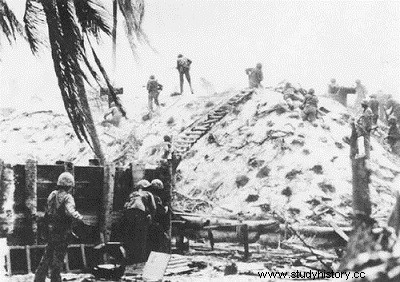
During the first studies concerning "Flintlock", the objectives retained had been the atolls of the eastern chain of the Marshall Islands. But, on December 7, during a conference bringing together the main officials, Admiral Nimitz proposed to strike a blow in the heart of the western chain, on Kwajalein atoll, which has the largest lagoon in the world. Spruance, Turner and Smith reacted forcefully to the idea of "blow up" the airbases of Kili, Maloelap and Wotje. The commander of the Fifth Fleet argued that he was obliged to deprive himself of part of his buildings for the benefit of the South West Pacific Fleet and that he could not, under these conditions, guarantee the neutralization of fortresses thus "outdated
Admiral Nimitz refuted all objections. He was only convinced on one point:the need to capture the atoll of Majuro, in the eastern Marshalls, to give Spruance the logistical base he wanted. In addition, Nimitz drew from the reserves the 106th Infantry Regiment (Army) to reinforce the landing troops. It was therefore Kwajalein and the two twin islands of Roi and Namu which were chosen as objectives in the Kwajalein atoll, the attack of which was definitively fixed for the end of January 1944.
The Admiral Turner had, with the 5th Amphibious Force, 2 command ships, 7 battleships, 12 cruisers and 75 destroyers for bombardment and escort; 46 transports, 27 freighters, 45 tank barges and 5 barge landing ships for the actual landing. Rear Admiral Mitscher, for his part, had for his Task Force 58 fast aircraft carriers, carrying some 750 aircraft, and escort ships. Her mission was first to take part in the preliminary bombardment, then to head west of Kwajalein to meet the Japanese fleet, in case it ventured out of its anchorage at Truk, in the Eastern Carolinas. Finally, throughout the preparation for the assault, taking off from bases recently set up on the Gilberts and on other islands with advanced land, army and fleet aircraft under Rear Admiral Hoover, were to attempt to neutralize the Marshall bases.
Admiral Nimitz's daring maneuver on Kwajalein took the Japanese by surprise. Most of the enemy leaders were expecting action against the eastern Marshall Range—which, incidentally, corresponded to the original American plans. They had therefore directed the few thousand reinforcements received at the end of 1943 on the atolls closest to the Allied bases.
During the Second World War, the most important head of German state security encouraged the creation of Nazi brothels inside the concentration camps. By Rainer Sousa At the height of Nazism, several scientific studies were encouraged in order to prove the superiority of the Aryan race over other p
